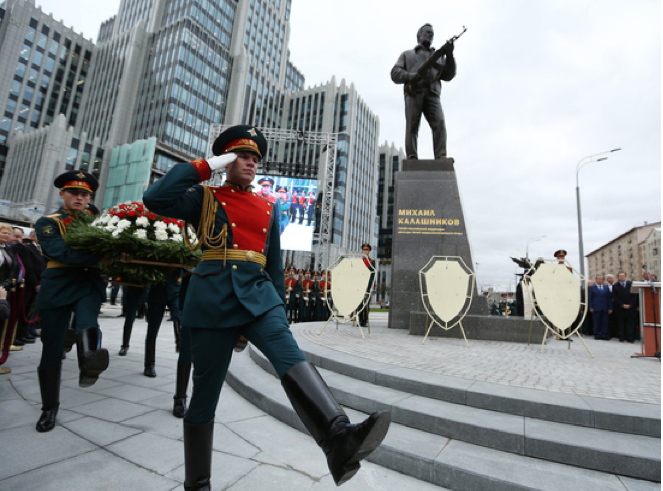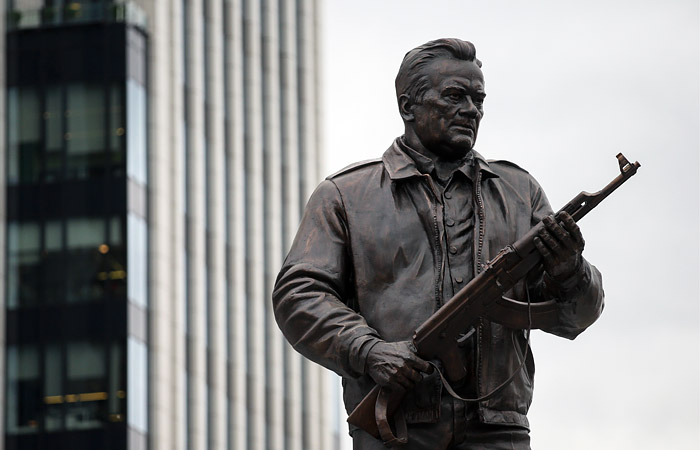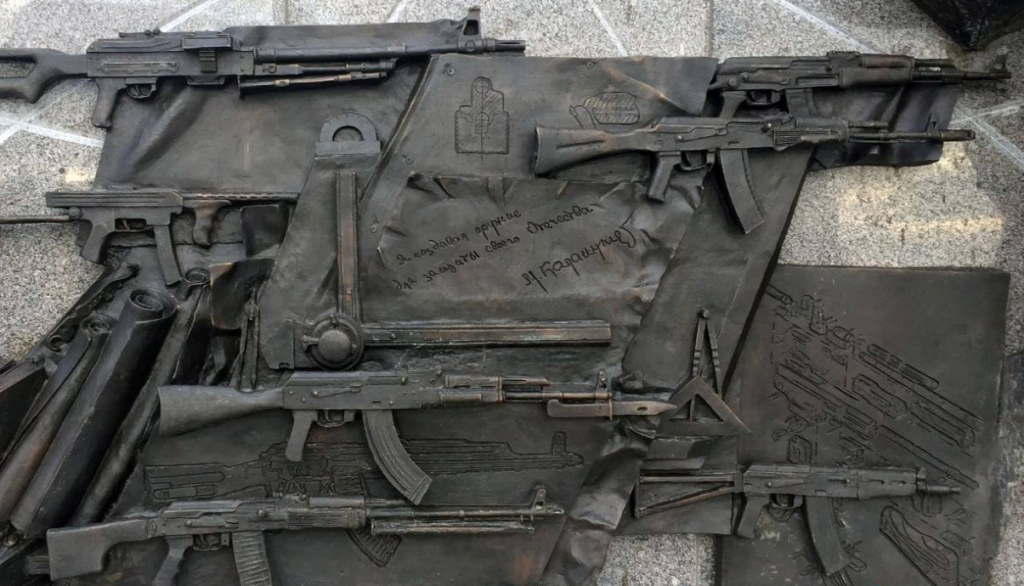On September 19, a monument to the world famous gunsmith Mikhail Kalashnikov was installed in one of central Moscow squares. At the unveiling of the monument soldiers in parade uniforms marched to a brass band. Vladimir Medinsky, the minister of culture of Russia, said the following.
“Mikhail Kalashnikov is, to some extent, the embodiment of the best features of a Russian person… The Kalashnikov assault rifle is a true cultural brand of Russia.”
The erection of the figure of Kalashnikov with his famous AK-47 gun in his hands in the center of Moscow provoked conflicting assessments.
Russian tradition gives special importance to monuments. They always were erected in order to send to people some special symbolic message and were often equivalent to idols. One of the first decrees of the Lenin’s government after the Bolshevik Revolution was the “Decree on Monumental Propaganda” “to demolish old idols and to replace them with new ones”. Monuments of Czars were demolished and monuments of revolutionaries were erected.
A year ago a monument of Prince Vladimir, who brought Christianity to Russia in 10th century, was erected near the Kremlin wall. A lot of Russians were against it.
The Kalashnikov monument was created by the same sculptor of the Prince Vladimir monument, Salavat Shcherbakov, a favorite artist of The Military History Society that was one of the sponsors of these monuments.
Some opponents of these new monuments found them tasteless and kitschy; others were worried about the growing of the militaristic-patriotic mood in Russia, the real cause of the monument erecting boom.
Here is the very typical evaluation of the event published in the popular website www.gazeta.ru:
“Even leaving aside aesthetics, the sponsor’s order is fulfilled really specifically: Kalashnikov holds the automatic rifle bearing his name carefully, like a mother would hold in her hands her baby most dear to her. That is, in fact, not a monument to the designer of the weapons, but a monument to the weapon itself … A completely militaristic image is built …
“Critics say that it would be strange to place in the center of the capital a monument of, say, Kurchatov (the constructor of Soviet atomic bomb) , gently stroking an atomic bomb. They say that such a monument is not ethical. In the 21st century it it appropriate in principle to put monuments to weapons of mass destruction? But enthusiasts note: “AK-47 is the strongest domestic brand that we have and Kalashnikov, is some one to be proud of.”
The brand is really very strong. There are already several monuments to Kalashnikov assault rifle in the world. Three are in Kamchatka, Egypt and China. The Kalashnikov assault rifle is otherwise depicted in East Timor, Zimbabwe and Mozambique, as well as on the Cook Islands coin.
By placing a monument to Kalashnikov, it appears the authors put Russia and Moscow in the company of North Korea and Mozambique.
But many would say: “So what?”
Yes, AK-47 is a brutal rifle, but at the end of the day it’s really effective.
In total, according to various sources, there are from 70 to 100 million Kalashnikov assault rifles of various modifications in the world, taking into account licensed and unlicensed copies. In 2011, Anatoly Serdyukov, then Minister of Defense of Russia, said that alone 17 million pieces of this automatic rifle are accumulated in Russian warehouses.
In a 2004 Small Arms Survey study, Kalashnikov assault rifles were accounted as about a fifth of all firearms in the world. In different years dozens of countries were armed with them, and in some of the countries they even got on state flags.
It is known that Kalashnikov himself was seriously worried and upset. The Russian Orthodox Church claimed that Kalashnikov even wrote a penitential letter.
“When I watch TV and see the weapons of the Kalashnikov family in the hands of bandits, I do not cease to ask myself: how did it get to these people?” said the designer, adding that production and exports must be controlled by governments, and not by inventors.
That is the root cause of the controversy raised in Russia in reaction to the erection of the new monument.
And not only that. There is an opinion that the AK-47 was really designed not by Kalashnikov, but by the famous German arms designer Hugo Schmeisser, who was a prisoner of war in Russia after the end of WWII and worked there as a head of the group of German engineers, also prisoners of war.
On the pedestal of the monument to Mikhail Kalashnikov was a bas-relief depicting a German assault rifle StG 44, developed by Hugo Schmeisser in 1944 and used by the Wehrmacht and the SS, instead of a Kalashnikov assault rifle. Attention was drawn to this detail by the military historian Yuri Pasholok, who published a photo of the part of the monument and the diagram of StG 44 on his page in Facebook.
The erroneous bas-relief was knocked off the pedestal. But its image remains in the Internet.
And the doubt remains in the minds of Russians whether it is right to erect in Moscow a doubtful monument to doubtful designer of the most popular weapon of death.




